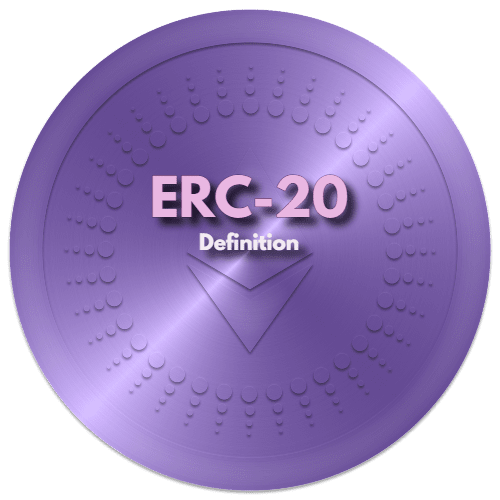ERC-20, what is it? If you’re interested in the world of cryptocurrencies, you can’t ignore them, do you know the definition.
ERC-20 designates a token (currency) model based on Ethereum, complying with precise specifications.
Since 2015, numerous variants of Ethereum have emerged, all based on the Ethereum blockchain. The specific features of each token are defined by a smart contract dedicated to the token in question.
ERC-20, definition:
To begin with, why is it called ERC-20?
ERC » stands for « Ethereum Request for Comment« , and « 20 » is the number assigned to this proposed enhancement.
This standard defines a set of functions that all Ethereum tokens must implement before they can be exchanged with each other on the Ethereum blockchain.
These functions include, among others, how tokens are transferred between Ethereum addresses, how users can access token data and how balances are verified.
ERC-20 tokens have gained in popularity because they are relatively easy to create and trade.
They are used to represent numerous digital assets such as governance tokens, payment tokens, stablecoin tokens and many others. What’s more, the ERC-20 standard standardizes exchanges between these tokens, making them easier to use and interoperable within the Ethereum ecosystem.
However, other token standards, such as ERC-721 (used for non-fungible tokens or NFTs), are also gaining in importance in specific areas of DeFi. Nevertheless, ERC-20 tokens remain among the most widespread and used in many DeFi protocols, thanks to their adaptability, ease of use and compatibility.
Are they the most widespread in the DeFi world?
It’s true that ERC-20 tokens are among the most widespread and widely used tokens in the world of decentralized finance (DeFi). DeFi includes a variety of financial applications built on blockchains, particularly Ethereum, that seek to create decentralized alternatives to traditional financial services.
The popularity of ERC-20 tokens in DeFi is due to several reasons:
- Interoperability: ERC-20 establishes standard rules for Ethereum tokens, making them compatible and easily exchangeable on various DeFi platforms without the need for major modifications.
- Liquidity: Many liquidity pools, decentralized exchanges (DEX) and lending platforms in the DeFi ecosystem support ERC-20 tokens. This offers high liquidity and the possibility of exchanges between different tokens.
- Diversity of use: ERC-20 tokens can represent a variety of assets, from stablecoins (tokens backed by stable currencies) to governance tokens, as well as other tokens representing various digital assets. Their versatility makes them a popular choice for a variety of DeFi use cases.
- Ease of development: Creating ERC-20 tokens is relatively straightforward, encouraging more projects to issue their own tokens compliant with this standard. This encourages diversity and expansion of the DeFi ecosystem.
Some examples of popular ERC-20 tokens?
There are many popular ERC-20 tokens that are widely used in the decentralized finance (DeFi) ecosystem as well as in other fields. Here are a few of the best-known:
USDC (USD Coin): This is a stablecoin backed by the US dollar, offering price stability and widely used for trading and transactions in DeFi.
DAI: Another decentralized stablecoin built on the Ethereum blockchain, created by MakerDAO. DAI is generated using collateral and stability mechanisms to maintain its parity with the dollar.
UNI (Uniswap): The governance token of the Uniswap protocol, a decentralized exchange (DEX) popular in DeFi. It is used to vote on governance proposals and can be used to share transaction fees.
LINK (Chainlink): A token used to power the decentralized Oracle Chainlink network, which provides data from external sources to smart contracts on the Ethereum blockchain.
AAVE: The native token of the Aave protocol, a decentralized lending and borrowing platform that enables users to provide and borrow funds in crypto-currencies.
YFI (yearn.finance): The native token for the Yearn.Finance protocol, which aims to optimize returns for DeFi investors by automating the lending and borrowing process across different protocols.
SNX (Synthetix): Used on the Synthetix platform, which enables the creation of synthetics (tokens representing real assets such as currencies, commodities, stocks, etc.) and the trading of these synthetic assets.
MKR (Maker): The MakerDAO protocol’s governance token, which enables holders to vote on proposed changes to the DAI creation system.
These tokens are among the most popular in the DeFi ecosystem, but there are many other ERC-20 tokens with different use cases, degrees of popularity and functionality within the Ethereum ecosystem.
What does the future hold for this token standard?
The ERC-20 standard has already played a crucial role in the growth of the Ethereum ecosystem, enabling the creation and interoperability of tokens on the blockchain. As for its future, here are a few possible perspectives:
- Evolving standards: Although ERC-20 is widely adopted, new standards could emerge to meet specific needs. Examples include ERC-721 for non-fungible tokens (NFTs) or ERC-1155, which combines the characteristics of fungible and non-fungible tokens. It is conceivable that these developments will lead to a diversification of token standards on Ethereum.
- Standard improvements: It’s possible that improvements or updates will be proposed for the ERC-20 standard. The aim of these changes could be to enhance security, improve transaction efficiency or offer new token functionalities.
- Integration and interaction with other blockchains: While Ethereum remains a major player in the blockchain ecosystem, other blockchains may adopt similar standards to enable the exchange of tokens between different networks. This could lead to enhanced interoperability between blockchains.
- Continued innovation in DeFi and beyond: DeFi continues to grow and diversify. New use cases for ERC-20 tokens could emerge, whether in the financial sector, gaming, governance systems or other areas.
- Regulation and standardization: Evolving regulations could have an impact on ERC-20 tokens, influencing them on aspects such as compliance, governance and use in financial applications.
- Decentralization and improved governance: Improvements in ERC-20 token governance mechanisms could be envisaged to increase community participation and decentralization.
In summary, the future of the ERC-20 standard is closely linked to ongoing innovation in the Ethereum ecosystem, changing user needs and technological advances. It is likely that this standard will remain relevant for some time, but it could also evolve or be complemented by new standards depending on advances in the blockchain field and market demand.


3 commentaires sur « ERC-20, what is it? »
Les commentaires sont fermés.